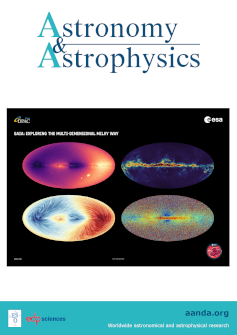极地光斑及其与太阳周期的关系
IF 5.8
2区 物理与天体物理
Q1 ASTRONOMY & ASTROPHYSICS
引用次数: 0
摘要
上下文。对太阳极地磁活动的研究对于理解太阳周期至关重要。然而,由于投影效应和极磁场本身较弱的磁场强度,测量极磁场带来了挑战。光斑是可见太阳表面与增强的磁场活动相关的明亮区域,它为测量极地磁场提供了一个有价值的代理。这项研究的目的是通过使用极光斑来分析太阳极地的磁活动。利用神经网络模型(U-Net)对太阳动力学观测台(SDO)上的日震磁成像仪(HMI)图像中的极光斑进行检测。该模型在合成数据上进行训练,消除了人工标注的需要,并用于分析2010年5月至2024年5月的14年数据。与现有方法相比,U-Net模型表现出卓越的性能和效率,能够实现自动化的大规模研究。我们发现,极地光斑数量表现出明显的极小值和最大值的周期性行为,在两极之间表现出相似的模式,但存在显著的时间延迟(南极:2014年初最小,2016年底最大;北极:2014年末最小,2019年中最大)。极地光斑磁场在两极和整个太阳周期内保持一致的量级(±75 G)。发现极性光斑数与整体极性磁场强度之间存在很强的线性相关关系。时空演化揭示了从中纬度向两极以3 ~ 8 m/s的速率系统迁移的磁场极性反转。在太阳极小期,我们观察到与太阳极大期相比,强场光斑的相对增加较小,这表明两种磁分布共存或光斑性质与太阳周期有微妙的关系。本文章由计算机程序翻译,如有差异,请以英文原文为准。
Polar faculae and their relationship to the solar cycle
Context. The study of magnetic activity in the Sun's polar regions is essential for understanding the solar cycle. However, measuring polar magnetic fields presents challenges due to projection effects and their intrinsically weak magnetic field strength. Faculae, bright regions on the visible solar surface associated with increased magnetic activity, offer a valuable proxy for measuring polar fields.Aims. This research aims to analyze the magnetic activity of the Sun's polar regions through the use of polar faculae.Methods. A neural network model (U-Net) was employed to detect polar faculae in images from the Helioseismic and Magnetic Imager (HMI) on board the Solar Dynamics Observatory (SDO). The model was trained on synthetic data, eliminating the need for manual labeling, and was used to analyze 14 years of data from May 2010 to May 2024.Results. The U-Net model demonstrates superior performance and efficiency over existing methods, enabling automated large-scale studies. We find that polar faculae numbers exhibit cyclical behavior with distinct minima and maxima, showing similar patterns between poles but with notable temporal delays (south pole: minimum early 2014, maximum late 2016; north pole: minimum late 2014, maximum mid-2019). Polar faculae magnetic fields remain consistent in magnitude (∼±75 G) across both poles and throughout the solar cycle. A strong linear correlation was found between the polar faculae count and the overall polar magnetic field strength. The spatio-temporal evolution reveals systematic migration of field polarity reversals from mid-latitudes toward the poles at rates of 3−8 m/s. During solar minimum, we observe a small relative increase in stronger-field faculae compared to solar maximum, suggesting either the coexistence of two magnetic distributions or subtle solar cycle dependence in faculae properties.
求助全文
通过发布文献求助,成功后即可免费获取论文全文。
去求助
来源期刊

Astronomy & Astrophysics
地学天文-天文与天体物理
CiteScore
10.20
自引率
27.70%
发文量
2105
审稿时长
1-2 weeks
期刊介绍:
Astronomy & Astrophysics is an international Journal that publishes papers on all aspects of astronomy and astrophysics (theoretical, observational, and instrumental) independently of the techniques used to obtain the results.
 求助内容:
求助内容: 应助结果提醒方式:
应助结果提醒方式:


